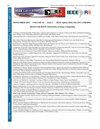注意块利用U-Nets改善白质高强度语义分割
IF 1.3
4区 工程技术
Q3 COMPUTER SCIENCE, INFORMATION SYSTEMS
引用次数: 0
摘要
白质高强度(WMHs)是老年人磁共振(MR)图像上的常见发现,在流体衰减反转恢复(FLAIR)成像上表现为高信号强度区域。在控制血管危险因素的情况下,WMH体积高的人患痴呆和中风的风险增加,但临床实践中对WMH负担的评估并不可靠。人工分割wmh是公认的金标准(或基础真理),但它是一种费时费力的方法。新的基于机器学习(ML)的方法被提出作为人工分割的替代方案。在这些方法中,U-Net卷积神经网络表现出了良好的WMH分割性能。然而,即使是最先进的ML模型有时也无法以足够的精度正确识别wmh及其边界。通过增强模型关注数据中相关特征的能力,注意力块已经成为改善U-Net模型性能的一种潜在解决方案。与其他三种模型(U-Net++、U-Net3+和标准U-Net)相比,我们研究了U-Net模型中注意力块对WMH分割的有效性。在不同的脑成像数据集中,注意力块显著提高了WMH分割的f测量得分(0.811 vs 0.789,次优模型,p=0.04)。本研究表明,注意块增强了用于WMH识别和分类的U-Net模型。本文章由计算机程序翻译,如有差异,请以英文原文为准。
Attention Blocks Improve White Matter Hyperintensity Semantic Segmentation using U-Nets
White matter hyperintensities (WMHs) are a common finding on magnetic resonance (MR) images in older individuals, appearing as high-signal intensity regions on fluid-attenuated inversion recovery (FLAIR) imaging. People with high WMH volume are at increased risk for dementia and stroke, controlling for vascular risk factors, but WMH burden is not reliably assessed in clinical practice. Manual segmentation of WMHs is accepted as the gold standard (or ground truth), however, it is a laborious and time-consuming method. Newer machine learning (ML)-based approaches are being proposed as alternatives to manual segmentation. Among these approaches, U-Net convolutional neural networks have demonstrated good WMH segmentation performance. However, even state-of-the-art ML models sometimes fail to correctly identify WMHs and their boundaries with sufficient accuracy. Attention blocks have emerged as a potential solution for improving the performance of U-Net models by enhancing the ability of the model to focus on relevant features in the data. We investigated the effectiveness of attention blocks in U-Net models for WMH segmentation compared to three other models (U-Net++, U-Net3+, and a standard U-Net). Attention blocks significantly improved the F-measure score for WMH segmentation (0.811 vs 0.789 for next best model, p=0.04) in a diverse brain imaging dataset. This study demonstrates that attention blocks enhance U-Net models used for WMH identification and classification.
求助全文
通过发布文献求助,成功后即可免费获取论文全文。
去求助
来源期刊

IEEE Latin America Transactions
COMPUTER SCIENCE, INFORMATION SYSTEMS-ENGINEERING, ELECTRICAL & ELECTRONIC
CiteScore
3.50
自引率
7.70%
发文量
192
审稿时长
3-8 weeks
期刊介绍:
IEEE Latin America Transactions (IEEE LATAM) is an interdisciplinary journal focused on the dissemination of original and quality research papers / review articles in Spanish and Portuguese of emerging topics in three main areas: Computing, Electric Energy and Electronics. Some of the sub-areas of the journal are, but not limited to: Automatic control, communications, instrumentation, artificial intelligence, power and industrial electronics, fault diagnosis and detection, transportation electrification, internet of things, electrical machines, circuits and systems, biomedicine and biomedical / haptic applications, secure communications, robotics, sensors and actuators, computer networks, smart grids, among others.
 求助内容:
求助内容: 应助结果提醒方式:
应助结果提醒方式:


